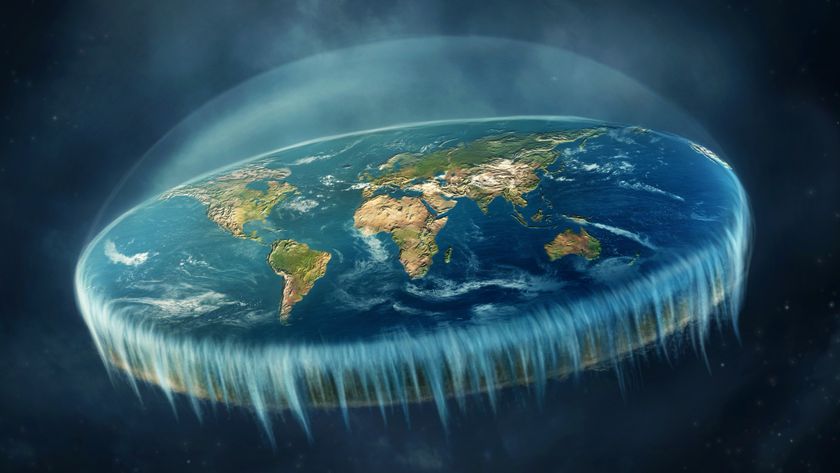The 7 Silliest Time Travel Concepts in Science Fiction
Silly time travel

Time travel has been a standard of science fiction since H.G. Wells' "The Time Machine" came out in 1895, but fictional people have been hopping through time and space for hundreds of years, from the Hindu sacred text the "Mahabharata" to the 12th-century medieval text De nugis curialium.
But just because people have been thinking about time travel for centuries now doesn't mean all of their accounts make sense. Here are the seven of the worst time travel concepts to be found in modern fiction. These explanations for time travel, given what scientists currently know, are total nonsense.
So science fiction that doesn't even try to explain its time travel, such as "A Connecticut Yankee in King Arthur's Court," or that brushes past explanation with non-answers like the infamous "wibbly wobbly timey-wimey" line in "Doctor Who" don't count.
Star Trek

The original "Star Trek" often walked the line between what writers call "hard science fiction" and "soft science fiction" — i.e. the difference between scrupulously researched hypotheses and techno-magic.
But perhaps the classic 1966 TV show's most egregious scientific misstep was in season 1 episode 21, "Tomorrow is Yesterday," when the Enterprise crew first traveled through time by slingshotting around the sun.
That's right, twice in the episode, the Enterprise travels hundreds of years through time by moving at an extremely high speed relative to a celestial body with a strong gravitational pull. That pull supposedly created a "time warp," thus "slingshotting" the ship into the past (in the beginning of the episode) or the future (at the end of the episode).
There is some method to this madness: The writers were clearly inspired by Einstein's theory of relativistic travel, which states that starships traveling at high speeds through space would experience time at a slower rate than on the planets they left behind, thus achieving a form of time travel into the future.
And the initial "slingshot" time travel into the past is achieved using the gravitational pull of a black star. There's a kernel of veracity buried here: Black hole singularities do distort the space-time around them, so theoretically if a ship were to get caught in its gravitational pull and then escape, it would have traveled into the future relative to its onboard timekeeping system.
But time travel into the past is a much different creature than time travel to the future, and if time itself can't escape from a black hole, how could a starship?
What's worse, the "slingshot effect" was a pivotal plot point in "Star Trek IV: The Voyage Home," the movie that effectively marked the end of the original "Star Trek" franchise.
(Editor's Note: this entry was updated to correct the episode in which slingshotting was first used.
Escape from the Planet of the Apes

The third in the "Planet of the Apes" series begins with the Earth being destroyed in a massive nuclear explosion. Three apes escape the destruction by restoring a spaceship and flying away from the doomed planet, but they're caught in a shock wave and end up going through a time warp — a catchall for time travel in science fiction — created by the explosion.
What the "Planet of the Apes" crew is talking about sounds more like a wormhole, which is a theoretical tunnel through space-time that could also be used to travel faster than light or, possibly, travel forward or back in time.
According to current understanding, creating a wormhole requires large amounts of a theoretical substance called dark matter. Dark matter has nothing to do with a nuclear explosion. Now, it's true that no one's ever blown up the Earth to see what would happen, so it's impossible to say for sure, but it's pretty safe to say that the titular escape in "Escape from the Planet of the Apes" has no scientific basis, and just amounts to yet another example of Hollywood solving all its plot problems with explosions.
Dr. Who
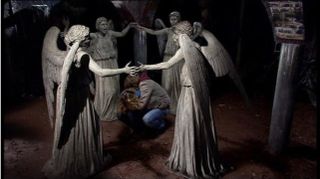
This long-running British television show is infamous for playing fast and loose with time travel. But even for a show whose main character travels unrestricted through time and space, the beings known as Weeping Angels are kind of a stretch, albeit terrifyingly cool.
That whole thing about how they kill people by sending them back in time so they "live to death," and then feed off of the "potential energy" of all the things their victims would have done in their original time — that's ridiculous.
First of all, how would the act of sending someone back in time create energy? Take the idea of opening a traversable wormhole through time and space, a theory of time travel that appears to be supported by Einstein's General Relativity. Opening that wormhole would require an enormous amount of energy known as dark energy, or negative energy.
That aside, when a person goes into a traversable wormhole, there's no reason he or she would leave behind potential energy of what would have been. It's poetic, but scientifically speaking it doesn't make much sense, even for "Doctor Who."
Time and Again
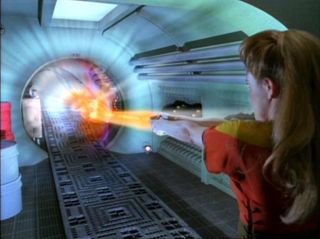
In this sci-fi novel by Jack Finney, main character Simon Morley becomes a test subject in the U.S. military's time travel research, something that's not too far-fetched — the U.S. military was researching some wacky stuff in the 60s and 70s, including whether LSD could give people psychic powers and the chemical weapon known as the "gay bomb" that was supposed to make enemy troops suddenly and aggressively infatuated with each other.
In "Time and Again," the government's testing a hypothesis that if they can convince a person he has traveled through time, then that person will have traveled through that time. To that end, Morley is isolated and surrounded only with things that evoke New York City in 1882.
The experiment is successful: Morley actually travels to 1882 and back several times through the course of the book and even alters the course of history.
Thematically, the use of belief and self-hypnosis as a means of time travel makes for a good story. Scientifically, however, there isn't really much to say about this one except that, barring some extraordinary discovery that fundamentally changes the way we understand the laws of the universe, "Time and Again" has absolutely zero scientific support.
Back to the Future
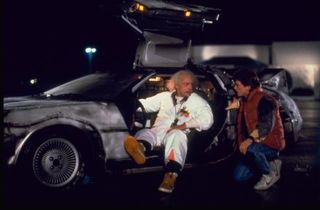
In this classic 80s movie, Doc Brown (Christopher Lloyd) turns a DeLorean car into a time machine by installing a flux capacitor, pumping 1.21 gigawatts of electricity through it, and then speeding the car up to 88 mph (140 km/h).
"Back to the Future" is a bit of a tricky one for this list, because the now iconic "flux capacitor" is the source of time travel, though there is no explanation on how the capacitor works.
A capacitor is a device that stores electricity by creating an electrical field between two charged but not touching metal plates. "Flux" refers to the flow of something through space and can be used to refer to time. So perhaps the flux capacitor is special because its wishbone shape means it has three metal plates?
Most theories of time travel also require the time machine to be traveling at extremely high velocities (as with the time dilation that occurs at relativistic speeds) or using a warp drive or wormhole to cut through space-time, thus moving from one place to another in an amount of time that seems like the vessel is moving faster than the speed of light.
In that context, why make the DeLorean's time travel cutoff point 88 mph? The writers chose "88," because the number "8" looks like an infinity symbol (∞) turned on its side, suggesting infinitely high speeds. [Now and Then: 10 Mind-Bending Time Travel Stories in Comics]
The Time Traveler's Wife

In this 2003 romantic novel by Audrey Niffenegger, a woman named Clare must endure not knowing when and where her time-hopping husband Henry is.
Narratively, "The Time Traveler's Wife" is a unique take on time travel as a literary trope, as well as a lovely allegory about the difficulty of maintaining a relationship over time.
But scientifically, the book's time travel is baseless. Henry's time-surfing is ascribed to a genetic disorder called "Chrono-Impairment," which is hardly explored beyond its establishment as the pseudoscientific premise for Clare and Henry's tragic romance.
It's probably safe to say that if and when scientists discover the key to time travel, they won't find it in human DNA.
Superman: The Movie
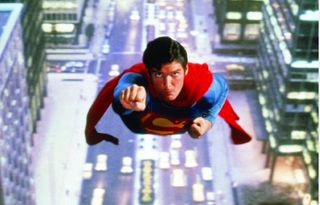
You'd be hard-pressed to find a worse example of bogus time travel than the infamous "flying backwards around the Earth" scene in the 1978 "Superman" film starring Christopher Reeve and Margot Kidder.
In the movie, Superman reverses Lois Lane's death by flying counter-clockwise around the Earth so fast that he reverses the earth's spin and therefore rewinds time. [Superman's 10 Strangest Powers]
This is insane for several reasons, the most significant being Earth's spin has nothing to do with the passage of time.
But let's say Superman were capable of influencing the Earth's spin, which moves at a speed of over 1,000 mph (1,600 km/h) at the equator. If the Earth were suddenly to stop spinning, let alone spin in the reverse direction, all objects on the surface would suddenly jolt forward.
In the movie, Lois was in California when Superman spun the Earth backward, not at the equator, so she'd be thrown forward at a rate of less than 1,000 mph — maybe only 500 or 600 mph. That'd still be enough to kill her all over again before Superman could get to her.
Sign up for the Live Science daily newsletter now
Get the world’s most fascinating discoveries delivered straight to your inbox.
